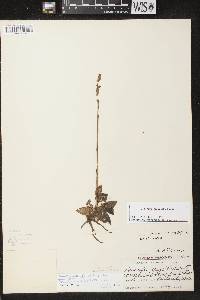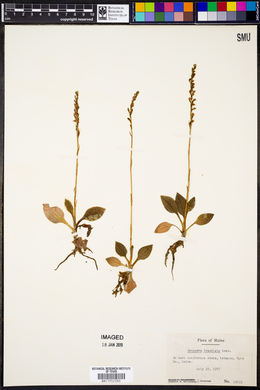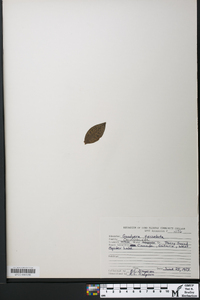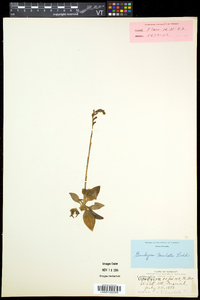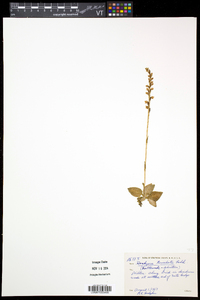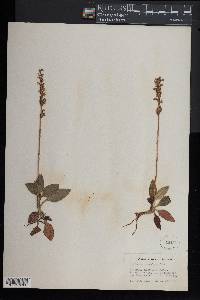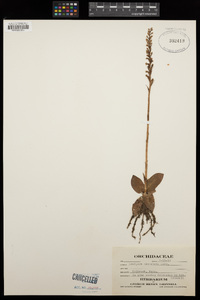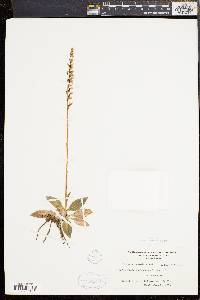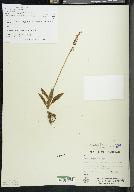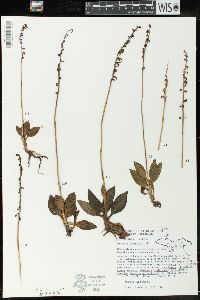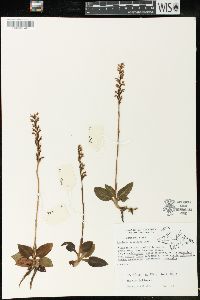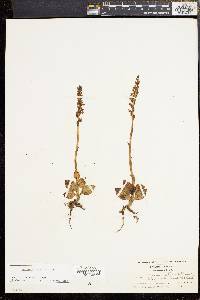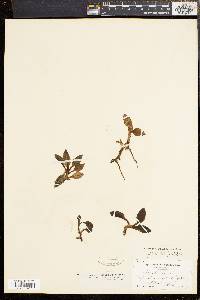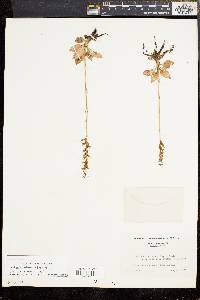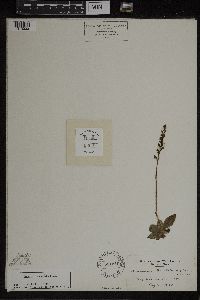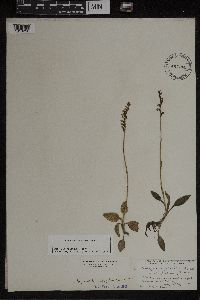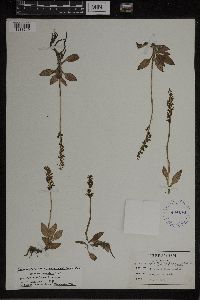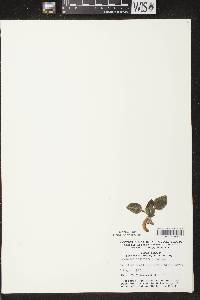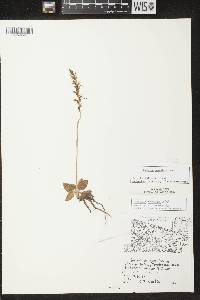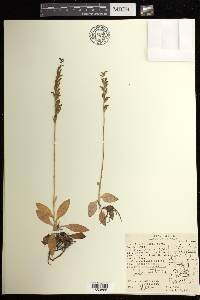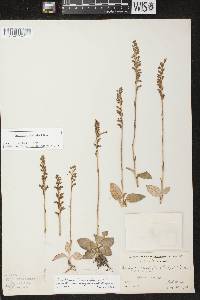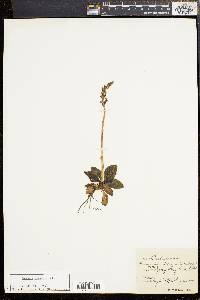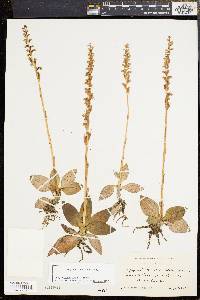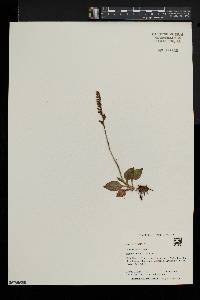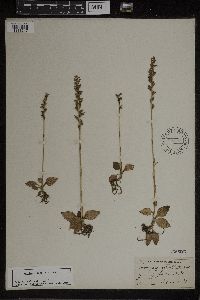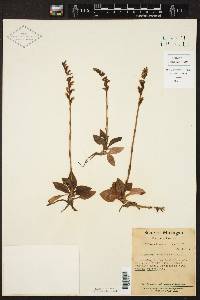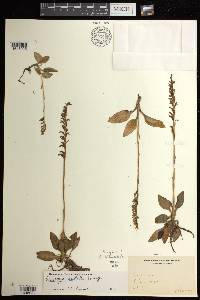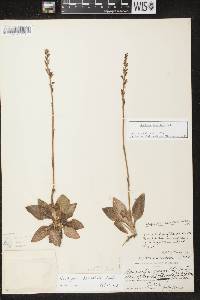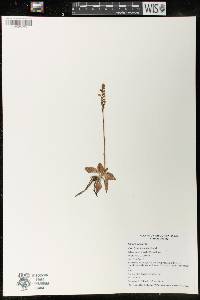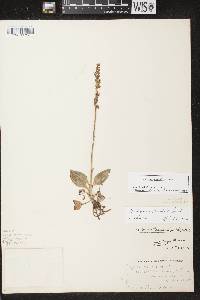
|
|
|
|
Family: Orchidaceae
Checkered Rattlesnake-Plantain
|
Leaves: blade with lateral veins and sometimes midrib prominently to faintly bordered with bands of white, gray, or paler green tissue frequently merging, giving leaf rather blotched appearance, especially near margins and apex where veins are closer together, infrequently uniformly green or with only midrib whitened, narrowly elliptic to ovate, 1.4-5.5 × 0.9-2.6 cm, apex usually acute. Inflorescences densely to loosely spiraled or secund, 5-72-flowered; peduncle 6-23 cm. Flowers: lateral sepals 3.8-6 mm; petals connivent; hood 3.9-7.1 mm; lip deeply concave to saccate, 3-5.5 × 1.2-3.1 mm, apex spreading or recurved, blunt or acute, inner surface with 2 or 4 unequal rows of glandular papillae; anther erect, base 0-1/3 immersed in shallowly concave to cup-shaped clinandrium, apex apiculate to acuminate; pollinia acute or short-acuminate; rostellar beak 2-pronged, 0.6-1.7 mm, equal to or longer than body of stigma; viscidium elliptic. 2n = 45, 60. Flowering mid Jul--early Sep. More common in dry or moist, upland, coniferous or mixed woods, less frequent in white-cedar swamps, margins of spruce-tamarack bogs; to 300 m; Man., N.B., Nfld. and Labr. (Nfld.), N.S., Ont., P.E.I., Que.; Conn., Maine, Md., Mass., Mich., Minn., N.H., N.J., N.Y., Ohio, Pa., R.I., Vt., Wis. Goodyera tesselata is almost completely restricted to once-glaciated areas in the Great Lakes region, the northeastern United States, and adjacent Canada. Goodyera tesselata tends to be taller and to have larger leaves, more cauline bracts, more flowers, and longer perianths than Goodyera repens. Although overlap exists in any count or measurement, the two are, for the most part, easily distinguishable. Some of the difficulty in identifying ambiguous specimens is explained by the hypothesis (J. A. Kallunki 1976) that G. tesselata itself is intermediate between and a probable allotetraploid of G. repens with white-reticulate leaves and G. oblongifolia. Because the tetraploids and the triploid hybrids (2n = ca. 45) cannot be distinguished with certainty by their morphology, the description here includes individuals of both tetraploid and triploid individuals. In the extreme, individuals of G. tesselata (in the broad sense) approach G. repens more often than G. oblongifolia, and it is sometimes impossible to distinguish some triploids from G. repens with white-reticulate leaves.
Intermediate in most respects between nos. 2 [Goodyera oblongifolia Raf.] and 4 [Goodyera repens (L.) R. Br.], and very probably of alloploid origin; plants 1.5-3.5 dm; scape with 3-5 bracts; lf-blades mostly 2-5.5 cm, variably white-reticulate, the extremes approaching the putatively ancestral spp.; galea 4-7 (avg 5) mm; lip 3-5.5 mm, shallowly saccate, the pouch longer than deep; anther acuminate, somewhat surpassed by the 0.6-1.7 mm rostellar beak; 2n=60. Rich coniferous or hardwood forests; Nf. to se. Man., s. to N.J., Md., O., Mich., Wis., and Minn. July, Aug. (Epipactis t.; Peramium t.) Gleason, Henry A. & Cronquist, Arthur J. 1991. Manual of vascular plants of northeastern United States and adjacent Canada. lxxv + 910 pp. ©The New York Botanical Garden. All rights reserved. Used by permission. |
This project was made possible in part by the Institute of Museum and Library Services [MG-70-19-0057-19].
Powered by Symbiota

